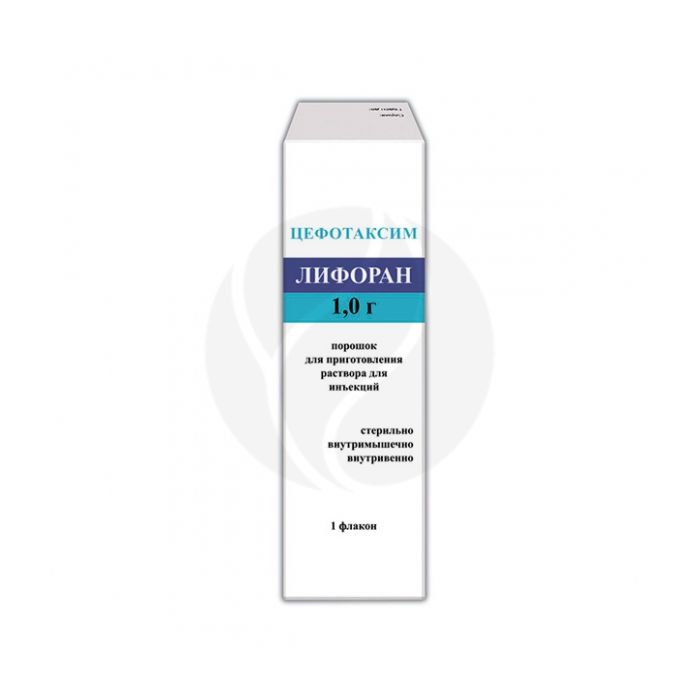Liforan (Cefotaxime) powder for solution for injection 1g, No. 1
Expiration Date: 05/2027
Russian Pharmacy name:
Лифоран (Цефотаксим) порошок для приготовления раствора для инъекций 1г, №1
Cefotaxime is used for infections caused by microorganisms sensitive to it (mainly gram-negative):
infections of the respiratory and urinary tract of the kidneys;
ear nose throat infections septicemia endocarditis meningitis;
infections of the bones and soft tissues of the abdominal cavity;
with gynecological infectious diseases of gonorrhea;
wound and burn infections and others.
Cefotaxime is used intramuscularly and intravenously.
For intramuscular injection, dissolve 025 or 05 g of the drug in 2 ml (respectively, 1 g in 4 ml) of sterile water for injection is injected deep into the gluteus muscle. As a solvent for intramuscular administration, 1% lidocaine is also used (for 05 g - 2 ml for 1 g - 4 ml).
For intravenous administration, 05-1 g of cefotaxime is dissolved in 4 ml (2 g - 10 ml) of sterile water for injection. Enter slowly over 3-5 minutes.
For drip (within 50-60 minutes) dissolve 2 g of the drug in 100 ml of isotonic sodium chloride solution or 5% glucose solution.
The usual dose of cefotaxime for adults and children over 12 years of age is 1 g every 12 hours. In severe cases, the dose is increased to 3 or 4 g per day, the drug is administered 3 or 4 times 1 g each. The maximum daily dose, depending on the severity of the disease, can be increased to 12 g. The usual dose for newborns and children under 12 years of age is 50-100 mg / kg body weight per day at intervals of 6 to 12 hours. For premature babies, the daily dose should not exceed 50 mg / kg.
In case of impaired renal function, the dose is reduced. With a creatinine clearance of 10 ml / min or less, the daily dose of the drug is halved.
Powder for preparation of solution for injections from almost white to slightly yellow color.
1 fl.
cefotaxime sodium salt 1 g
Children under 2.5 years of age (for intramuscular injection);
hypersensitivity to cephalosporins.
The drug should be prescribed with caution in case of impaired liver and kidney function.
Pharmacodynamics:
Pharmacological properties
Cefotaxime is a third generation cephalosporin antibiotic for parenteral use. It has a bactericidal effect. Possesses a wide spectrum of antimicrobial action.
Pharmacodynamics
Highly active against gram-negative microorganisms resistant to other antibiotics: E. coli Citobacter Proteus mirabilis Proteus indole Providencia Klebsiella Serratia some strains of Pseudomonas Haemophilus influenzae. Less active against gram-positive cocci, mainly staphylococci. The drug is highly resistant to beta-lactamases of gram-negative bacteria.
Pharmacokinetics:
Cefotaxime is used intramuscularly and intravenously. When administered intramuscularly, the drug is absorbed quickly. The peak concentration in blood plasma is observed 30 minutes after injection. The bactericidal concentration in the blood lasts for more than 12 hours. The drug penetrates well into tissues and body fluids; is found in effective concentrations in the pleural peritoneal synovial fluids. Unlike earlier cephalosporins, it crosses the blood-brain barrier. As a result of biotransformation, an active metabolite is formed. It is excreted in significant quantities in the urine unchanged (about 30%) and in the form of active metabolites (about 20%). Partially excreted in the bile.
Pregnancy and lactation:
The use of the drug during pregnancy is possible only if the intended benefit to the mother outweighs the potential risk to the fetus.
Cefotaxime is excreted in breast milk, therefore, if it is necessary to prescribe the drug during lactation, breastfeeding should be discontinued.
Side effects:
When using cefotaxime, allergic reactions are possible (skin rash, fever anaphylactic shock) indigestion (dyspeptic phenomena pseudomembranous colitis (rarely) violations of liver function tests) an increase in the number of eosinophils leukopenia neutropenia agranulocytosis hemolytic anemia increased alkaline phosphatase and nitrogen content in the urine.
Pain redness and swelling at the injection site.
The body temperature may rise.
Interaction:
With the simultaneous use of Cefotaxime with potentially nephrotoxic drugs (aminoglycoside antibiotics furosemide), it is necessary to monitor renal function (danger of nephrotoxic effects of the latter).
Cefotaxime solutions are incompatible with solutions of other antibiotics in the same syringe or dropper.
Special instructions:
Before prescribing the drug, it is necessary to collect an allergic history, especially in relation to beta-lactam antibiotics. Cross-allergy is known between penicillins and cephalosporins. In persons with a history of which there are indications of allergic reactions to penicillin, the drug is used with extreme caution.
If hypersensitivity reactions occur (which are severe and even fatal), the drug is canceled.
If the duration of treatment with the drug is more than 10 days, it is necessary to control the picture of peripheral blood.
Detection of a false positive Coombs' test is possible.
When determining glucose in urine by a non-enzymatic method (for example, the Benedict method), false positive results are possible.

